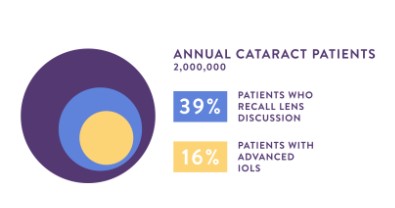Overcoming three barriers to cataract surgery and advanced IOLs
An estimated 4 million cataract procedures will be performed this year. Yet, according to Clinical Ophthalmology, cataract surgery patients reported that lens options were discussed only 39 percent of the time—meaning 61 percent of patients do not remember being counseled on lens options. It stands to reason that this may have an impact on patients who decide to move forward with the surgery at all, as well as those who opt for premium lenses. The market share for advanced IOLs in the U.S. is only 16 percent, according to Marketscope.

Given the ease and outcomes of cataract surgery, as well as the advanced lens technology now available, why are so many prospective patients still on the sidelines? Here are three reasons, and how to address them.
1. Safety concerns
We are still in a pandemic. And the rise in COVID-19 cases even in the vaccinated due to the Delta variant concerns many patients, particularly those who are older or more vulnerable. People want to know how you will keep them safe. Reassure patients by showing them what steps your practice is taking, whether that’s requiring masks, implementing new cleaning and sanitizing procedures, updating your air filtration system, or rearranging or eliminating your waiting room.
We are still in a pandemic, and patients–especially those who are older or more vulnerable–want to know what your practice is doing to keep them safe.
Another potential benefit of cataract surgery that is worth pointing out to patients who may be on the fence is that studies have shown it can significantly reduce the risk of falls in older people.
Also emphasize to patients that cataract surgery is the most frequently performed operation in the U.S., and “one of the safest and most highly perfected surgical procedures in medicine, with a 95 percent success rate,” according to the American Academy of Ophthalmology.
2. Cost
The cost of surgery may be an obstacle for some patients, who may not realize that advanced IOLs come with an out-of-pocket expense. Counsel each patient on the options available, regardless of what you think they may be interested in spending, advised Mitchell A. Jackson, M.D., in a meeting presentation, reported CRS Today.
“There is nothing wrong with offering multiple cataract surgery packages, as long as you comply with regulatory guidelines and bill appropriately,” said Dr. Jackson. He offers three packages to his patients—“basic,” “legal to drive,” and “forever young.”
You need to start by asking your patients questions about their lifestyle and expectations. Their responses will drive their decision. “Most of our patients are on the elderly side, and their biggest concern is losing their independence, and driving is independence,” Dr. Jackson said. He explains to his patients that the “legal to drive” package offers a lifetime of distance driving without glasses, whereas “the forever young” package offers a lifetime of improved vision at all distances. He added, “It is important to explain to the patient that contact lenses or glasses are more costly in the end.”
Some surgeons have found that conversions to advanced IOLs rose during the pandemic, possibly due to extra funds not being spent on travel or a ‘life is short’ philosophy.
Some eye doctors have found that conversions to premium IOLs are actually on the rise during COVID-19. This may be due to stimulus money, extra funds not being spent on travel or entertainment, or simply a “life is short” philosophy. In The Ophthalmologist’s “Refractive Recovery and COVID-19 Roundtable” last July, Sheraz Daya, M.D., said, “This pandemic has put a new perspective on things for people. They want to live life. And when you’ve got the opportunity to have visual freedom, well, why not take it?”
3. Lack of awareness
As the statistics above indicate, too many patients are not getting the message about the value and benefits of premium IOLs. This can be discouraging to doctors who feel like they already spend a great deal of time and energy counseling their patients. How can 61 percent not remember your conversations around lens options? The answer ties into the popular marketing guideline called the “Rule of Seven,” which states that it takes an average of seven iterations of your message before the desired action will take place.
Rendia makes it easy to attain the “Rule of Seven” marketing guideline that people need to see or hear your message seven times before taking action.
Rendia was designed for exactly this reason—to easily and efficiently educate your patients, with minimal lift from you and your staff. From patient education videos that can be shown on your website, via social media, and in your waiting room, to our cutting-edge Outcome Simulator that can be used by your surgical counselors during virtual visits as well as in-person appointments, that’s four patient touchpoints before the patient has even interacted with the surgeon. Rendia makes the “Rule of Seven” much easier to achieve.
In order to get the best results possible and improve their quality of life, patients need to understand the value of advanced IOLs. And doctors need to effectively convey to patients how options will enhance their lifestyle in a way that resonates. Another perk is that you can share Outcome Simulator virtually with family members or caregivers who may not be able to accompany patients to appointments.
Show patients how you can improve their quality of life
When you visually articulate the benefits and potential side effects of cataract surgery, patients can better envision what their experience will be—reducing their uncertainty and enabling them to make an informed decision. The Clinical Ophthalmology study found that of those who had had cataract surgery, 81 percent elected to do so on the advice of their health care provider. And three-quarters of post-op respondents reported a higher quality of life and said they wished they had had the surgery sooner.
It’s up to you to show patients what is possible for them, and how much better life can be with better vision.
Learn how Dr. Paul Karpecki uses Exam Mode to explain glaucoma and MIGS to patients with glaucoma and cataracts. Watch his 4-minute tutorial here.

